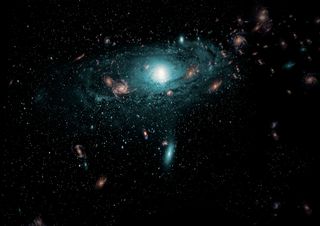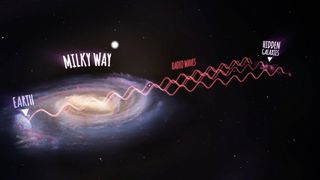Hundreds of Hidden Galaxies Glimpsed Behind Milky Way (Video)
A new telescope view has revealed hundreds of galaxies that were previously obscured by the Milky Way's bulk.
Scientists used an Australian radio telescope famous for assisting with the moon landings to peer through the gas and dust of the Milky Way, and uncovered 883 galaxies hidden behind it — one-third of which were never observed before. You can see how the hidden galaxies were found in this video.
This new view of the region could help explain something called the Great Attractor, which is a mysterious spot in the universe whose strong gravity pulls on the Milky Way and thousands of other galaxies with "the force equivalent to a million billion suns," researchers said in a statement. Scientists have known about the phenomenon since the 1970s.

"The Milky Way is very beautiful, of course, and it's very interesting to study our own galaxy, but it completely blocks out the view of the more distant galaxies behind it," lead author Lister Staveley-Smith, director of science with the International Centre for Radio Astronomy Research (ICRAR) said in the statement.
The new observations, made using the Commonwealth Scientific and Industrial Research Organization (CSIRO) Parkes Observatory, in Australia, found three new galaxy concentrations (NW1, NW2 and NW3) and two new clusters (CW1 and CW2). The researchers put a new, 21-centimeter (8.3 inches) multibeam receiver on the observatory that allowed it to map the sky 13 times faster than it had previously, officials said in the statement. Thus, they were able to pin down a region beyond the Milky Way that astronomers had wondered about for decades. With further work, the team hopes the discoveries will help explain observed anomalies within the universal expansion of the cosmos, like the Great Attractor, researchers said.

"We don't actually understand what's causing this gravitational acceleration on the Milky Way or where it's coming from," Staveley-Smith said.
Get the Space.com Newsletter
Breaking space news, the latest updates on rocket launches, skywatching events and more!
"We know that in this region there are a few very large collections of galaxies we call clusters or superclusters, and our whole Milky Way is moving towards them at more than 2 million km/h [1.2 million mph]," he added.
The research was detailed in The Astronomical Journal Feb. 9.
Follow Elizabeth Howell @howellspace, or Space.com @Spacedotcom. We're also on Facebook and Google+. Original article on Space.com.
Join our Space Forums to keep talking space on the latest missions, night sky and more! And if you have a news tip, correction or comment, let us know at: community@space.com.

Elizabeth Howell (she/her), Ph.D., is a staff writer in the spaceflight channel since 2022 covering diversity, education and gaming as well. She was contributing writer for Space.com for 10 years before joining full-time. Elizabeth's reporting includes multiple exclusives with the White House and Office of the Vice-President of the United States, an exclusive conversation with aspiring space tourist (and NSYNC bassist) Lance Bass, speaking several times with the International Space Station, witnessing five human spaceflight launches on two continents, flying parabolic, working inside a spacesuit, and participating in a simulated Mars mission. Her latest book, "Why Am I Taller?", is co-written with astronaut Dave Williams. Elizabeth holds a Ph.D. and M.Sc. in Space Studies from the University of North Dakota, a Bachelor of Journalism from Canada's Carleton University and a Bachelor of History from Canada's Athabasca University. Elizabeth is also a post-secondary instructor in communications and science at several institutions since 2015; her experience includes developing and teaching an astronomy course at Canada's Algonquin College (with Indigenous content as well) to more than 1,000 students since 2020. Elizabeth first got interested in space after watching the movie Apollo 13 in 1996, and still wants to be an astronaut someday. Mastodon: https://qoto.org/@howellspace
